Vermont Housing Trends
The General Assembly received a briefing this past Friday about the current trends in housing across Vermont. As our community here in Burlington is about to select new leadership, it is critical that we ask questions from a well informed perspective. Information here was provided by The Vermont Housing Finance Agency (VHFA), Capstone Community Action, and the Vermont Housing Conservation Board.
The full presentation is available at the Vermont Legislative Joint Fiscal Office website within their list of recent briefings. I’ll post a few slides here along with some brief comments.
So many of the concerns I hear Burlingtonians discuss can be sourced to our housing crisis. The increased visibility of our fellow Vermonters who are suffering from opioid use disorder, the inability of those we love to stay in Vermont due to low availability and increasingly high costs of rent and mortgages, and the impact on our workforce when employers are unable to recruit or retain workers due to the many hurdles involved with finding and affording housing — all of these can be directly sourced to this crisis. It becomes common practice to focus on one or two factors as we then look to leadership to create policy as the fix. I’m guilty of this myself as I continue to scrutinize UVM, one of our biggest employers and a significant factor impacting housing in the Chittenden 15 district, and their stated unwillingness to share any sort of enrollment plan while seeking exemptions to build new housing. I’ll continue to apply that scrutiny and will end this post with a graph that identifies the continued increase in enrollment for undergraduate students.
It is important, though, to consider all of the factors as we select leadership that will guide policy in the coming years — policy that will hopefully return Burlington as a city in which working families can afford to live and spread roots. I don’t pretend to have solutions to each of these factors. I do know that collective and collaborative problem solving will be required. Anyone willing to join in that collaboration will need the data presented here.
It’s no surprise to anyone that the rate of change in housing supply continues to decrease at alarming rates.
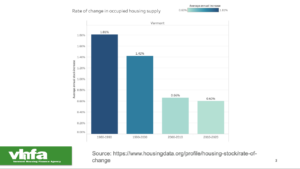
Simultaneously, the cost of building new affordable housing continues to escalate.
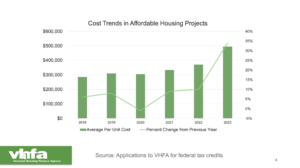
When you factor in the recent net migration to Vermont along with the predicted trends for climate migration and influx of those who will seek a more accepting political climate from areas of the country that are enacting hateful policy, we are likely to have more and more people searching for affordable housing that is currently not available.
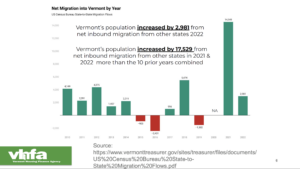
These factors, combined with the increasing cost of borrowing money to build or buy a home leaves more and more current renters stuck in the cycle of spending more on increasing rent while saving progressively less for houses that stay out of reach. Currently, fewer than 5,000 Vermont renters could afford to by a median priced home. This is down from nearly 25,000 just two years ago.
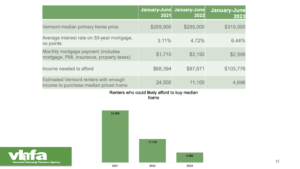
These are all factors largely outside of our control. We can’t create policy that lowers the cost of construction or forbids those that wish to migrate to Vermont and to Burlington for any variety of reasons. We can however consider a few factors that are impacting the amount of housing available for purchase or rent. We can also hold employers accountable for bringing Vermont wages out of compression and in line with what comparable salaries are across the country.
The amount of short term rentals have most certainly increased across the state. Burlington recently passed an ordinance that seeks to end the ability for landlords to utilize many of their properties as short term rentals. It will be critical that we enforce this ordinance and I will work to create legislation that replicates Burlington’s ordinance into state wide policy.
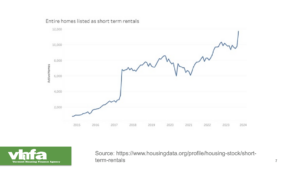
We can encourage our employers to respond to the need for more competitive wages here in Burlington and across the state. Wages are not keeping up with the cost of living and certainly not with the cost of home ownership.
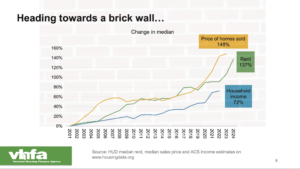
As we watch to see what happens with the Vermont State College system, we must support our UVM workers locally as they find increasing leverage through the unions that are developing across the entire campus workforce. In my estimation, morale at UVM is at an all time low. This is evidenced by the fact that nearly every employee has overwhelming voted to form a union for collective bargaining. I belong to UVM Staff United and am pleased that we raised the minimum wage for all workers included within our bargaining unit to a minimum of $20 per hour. The UVM administration is currently stalling continued negotiations that would evaluate our outdated system for job classification and compensation. Our initial contract tabled those decisions until this past summer of 2023 and the response from UVM to resuming those negotiations has been nothing but concerning. Recruiting and retaining a skilled workforce will require all employers to reconcile decades of compressed wages.
Finally, we must continue to pressure UVM to house more of its students and to remain transparent about its enrollment plan that has a disproportionate impact on the city wards and legislative districts immediately adjacent to campus. Recent history shows the clear trend of UVM expanding enrollment to beyond capacity within 5 years of building any new housing. Within this past year, UVM refused to provide any public statement on their enrollment plans when seeking a zoning exemption to build even more housing. With that refusal they assured the City Council that “enrollment is where we want it”. Since that statement, UVM again increased its undergraduate enrollment by 288 students. If those students move off campus in group of fours, they will require an additional 72 housing units and will be looking to sign those leases as early as September, 2024. Our neighborhoods simply cannot currently sustain this continued growth.
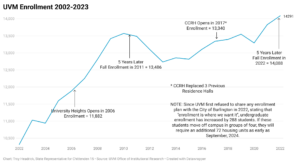
UVM is an obvious partner in our immediate neighborhoods as we navigate the factors listed above. Any new campus housing must commit to eliminating the need to house students in “forced triples” while providing attractive options to upperclass students for staying within the campus district after their initial two years. We must not allow any new housing to be approved until UVM commits to managing its enrollment plan and meaningfully contribute solutions to our city’s housing crisis.
That being said, UVM is one part of this puzzle. Returning Burlington to a vibrant and safe city with affordable housing for anyone who seeks it will absolutely require us all to remain open and imaginative to how we will accommodate the continued migration of people wanting to join our community. We are currently witnessing the increasingly frequent impact of decades of neglect to a “housing first” commitment. The increase in burglaries, along with the obvious and open impact of the substance use disorder escalation, are such examples. When we deny the basic need of shelter, it should not surprise us to find the resulting impact becoming more and more visible.
Our city will change. We must envision housing that becomes more dense and remain open to building up. Housing has to trump parking and driving. We can do this by building a more walkable and bike-able city center that houses working families closer to an improved public transportation infrastructure. We have a simple choice between building more housing in our neighborhoods or witnessing the continued impact of more and more of our Vermont neighbors without homes finding ways to survive nonetheless in those same neighborhoods. In short, it becomes critical to shift our prevailing paradigm of Not In My Backyard (NIMBY) to Yes In My Backyard (YIMBY).
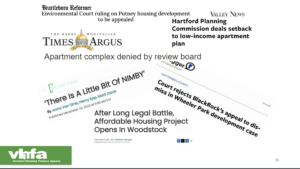
As you consider the factors outlined within this post, please do not hesitate to contact me for continued discussion. As I’ve already stated, the solutions to these factors that will remain outside of our control will most certainly require collaborative head scratching and plenty of compromise. Know that I am committed to those conversations.
